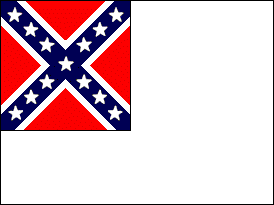


 |
|---|
The First Official Flag of the Confederacy. Although less well known than the "Confederate Battle Flags",the Stars and Bars was used as the official flag of the Confederacy from March 1861 to May of 1863. The pattern and colors of this flag did not distinguish it sharply fom the Stars and Stripes of the Union. Consequently, considerable confusion was caused on the battlefield.
The seven stars represent the original Confederate States; South Carolina (December 20, 1860), Mississippi(January 9, 1861), Florida (January 10,1861), Alabama (January 11, 1861), Georgia (January 19, 1861), Louisiana (January 26, 1861), and Texas (February 1, 1861).
 |
|---|
The Confederate Battle Flag. The best-known Confederate flag, however, was the
Battle Flag, the familiar
"Southern Cross". It was carried by Confederate troops in the field which were the
vast majority of forces under the confederacy.
The Stars represented the 11 states actually in the Confederacy plus Kentucky and
Missouri.
 |
|---|
The second Official Flag of the Confederacy. On May 1st,1863, a second design was adopted, placing the Battle Flag (also known as the "Southern Cross") as the canton on a white field. This flag was easily mistaken for a white flag of surrender especially when the air was calm and the flag hung limply.
The flag now had 13 stars having been joined officially by four more states, Virginia (April 17, 1861), Arkansas (May 6, 1861), Tennessee (May 7, 1861), North Carolina (May 21, 1861). Efforts to secede failed in Kentucky and Missouri though those states were represented by two of the stars.
 |
|---|
The third Official Flag of the Confederacy.On March 4th,1865, a short time before the collapse of the Confederacy, a third pattern was adapted; a broad bar of red was placed on the fly end of the white field.
 |
|---|
Confederate Navy Jack: Used as a navy jack at sea from 1863 onward. This flag has become the generally recognized symbol of the South.
Note: It is necessary to disclaim any connection of these flags to neo-nazis, red-necks, skin-heads and the like. These groups have adopted this flag and desecrated it by their acts. They have no right to use this flag - it is a flag of honor, designed by the confederacy as a banner representing state's rights and still revered by the South. In fact, under attack, it still flies over the South Carolina capitol building. The South denies any relation to these hate groups and denies them the right to use the flags of the confederacy for any purpose. The crimes committed by these groups under the stolen banner of the conderacy only exacerbate the lies which link the seccesion to slavery interests when, from a Southerner's view, the cause was state's rights.
Note contributed by BJ Meksikatsi.
After four years of arduous service, marked by unsurpassed courage and fortitude, the Army of Northern Virginia has been compelled to yield to overwhelming numbers and resources.
I need not tell the survivors of so many hard-fought battles who have remained steadfast to the last that I have consented to this result from no distrust of them; but feeling that valor and devotion could accomplish nothing that could compensate for the loss that would have attended the continuance of the contest, I determined to avoid the useless sacrifice of those whose past services have endeared them to their countrymen. By the terms of the agreement, officers and men can return to their homes and remain until exchanged.
You may take with you the satisfaction that proceeds from the consciousness of duty faithfully performed, and I earnestly pray that a merciful God will extend to you his blessing and protection.
With an unceasing admiration of your constancy and devotion to your country, and a grateful remembrance of your kind and generous consideration of myself, I bid you all an affectionate farewell.
He possessed every virtue of the great commanders, without their vices. He was a foe without hate; a friend without treachery; a private citizen without wrong; a neighbor without reproach; a Christian without hypocrisy, and a man without guilt. He was a Caesar without his ambition; a Frederick without his tyranny; a Napoleon without his selfishness; and a Washington without his reward. He was obedient to authority as a servant, and loyal in authority as a true king. He was gentle as a woman in life; modest and pure as a virgin in thought; watchful as a Roman vestal in duty; submissive to law as Socrates, and grand in battle as Achilles.
Even among the free, it is not always easy to live together. There came a time, less than a hundred years ago, when the people of this country disagreed so bitterly among themselves that some of them felt they could not go on living with the rest.
A test of arms was made to decide whether Americans should remain one nation or become two. The armies of those who believed in two nations were led by a man named Robert E. Lee.
What about Lee? What kind of man was he who nearly split the history of the United States down the middle and made two separate books of it?
They say you had to see him to believe that a man so fine could e,xist. He was handsome. He was clever. He was brave. He was gentle. He was generous and charming, noble and modst, admired and beloved. He had never failed at anything in his upright soldier's life. He was a born winner, this Robert E. Lee. Except for once. In the greatest contest of his life, in the war beween the South and the North, Robert E. Lee lost.
Now there were men who came with smouldering eyes to Lee and said: "Let's not accept this result as final. Let's keep our anger alive. Let's be grim and unconvinced, and wear our bitterness like a medal. You can be our leader in this."
But Lee shook his head at those men. "Abandon your animosities," he said, "and make your sons Americans."
And what did he do himself when his war was lost? He took a job as president of a tiny college, with forty students and four profes- sors, at a salary of $1500 a year. He had commanded thousands of young men in battle. Now he wanted to prepare a few hun- dred of them for the duties of peace. So the countrymen of Robert E. Lee saw how a born winner loses, and it seemed to them that in defeat he won his most lasting victory.
There is an art of losing, and Robert E. Lee is its finest teacher. In a democracy, where opposing viewpoints regularly meet for a test of ballots, it is good for all of us to know how to lose occasionally, how to yield peacefully, for the sake of freedom. Lee is our master in this. The man who fought against the Union showed us what unity means.
[ Historic Flags ]
[ History ]
[ Patriotic Writings ]
[ Miscellaneous ]
[ & Etcetera ]
[ Links to Web Sites of Special Interest]

 Home Page ]
[ Table of Contents ]
Home Page ]
[ Table of Contents ]
![]()